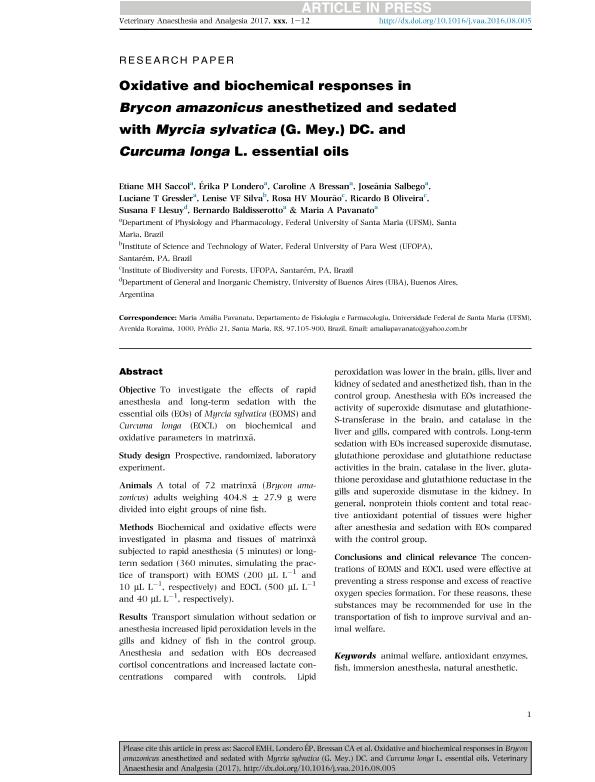Artículo
Oxidative and biochemical responses in Brycon amazonicus anesthetized and sedated with Myrcia sylvatica (G. Mey.) DC. and Curcuma longa L. essential oils
Saccol, Etiane M. H.; Londero, Érika P.; Bressan, Caroline A.; Salbego, Joseânia; Gressler, Luciane T.; Silva, Lenise V. F.; Mourão, Rosa H. V.; Oliveira, Ricardo B.; Llesuy, Susana Francisca ; Baldisserotto, Bernardo; Pavanato, Maria A.
; Baldisserotto, Bernardo; Pavanato, Maria A.
 ; Baldisserotto, Bernardo; Pavanato, Maria A.
; Baldisserotto, Bernardo; Pavanato, Maria A.
Fecha de publicación:
05/2017
Editorial:
Wiley Blackwell Publishing, Inc
Revista:
Veterinary Anaesthesia And Analgesia
ISSN:
1467-2987
Idioma:
Inglés
Tipo de recurso:
Artículo publicado
Clasificación temática:
Resumen
Objective: To investigate the effects of rapid anesthesia and long-term sedation with the essential oils (EOs) of Myrcia sylvatica (EOMS) and Curcuma longa (EOCL) on biochemical and oxidative parameters in matrinxã.
Study design: Prospective, randomized, laboratory experiment.
Animals: A total of 72 matrinxã (Brycon amazonicus) adults weighing 404.8 ± 27.9 g were divided into eight groups of nine fish.
Methods: Biochemical and oxidative effects were investigated in plasma and tissues of matrinxã subjected to rapid anesthesia (5 minutes) or long-term sedation (360 minutes, simulating the practice of transport) with EOMS (200 μL L−1 and 10 μL L−1, respectively) and EOCL (500 μL L−1 and 40 μL L−1, respectively).
Results: Transport simulation without sedation or anesthesia increased lipid peroxidation levels in the gills and kidney of fish in the control group. Anesthesia and sedation with EOs decreased cortisol concentrations and increased lactate concentrations compared with controls. Lipid peroxidation was lower in the brain, gills, liver and kidney of sedated and anesthetized fish, than in the control group. Anesthesia with EOs increased the activity of superoxide dismutase and glutathione-S-transferase in the brain, and catalase in the liver and gills, compared with controls. Long-term sedation with EOs increased superoxide dismutase, glutathione peroxidase and glutathione reductase activities in the brain, catalase in the liver, glutathione peroxidase and glutathione reductase in the gills and superoxide dismutase in the kidney. In general, nonprotein thiols content and total reactive antioxidant potential of tissues were higher after anesthesia and sedation with EOs compared with the control group.
Conclusions and clinical relevance: The concentrations of EOMS and EOCL used were effective at preventing a stress response and excess of reactive oxygen species formation. For these reasons, these substances may be recommended for use in the transportation of fish to improve survival and animal welfare.
Archivos asociados
Licencia
Identificadores
Colecciones
Articulos(IBIMOL)
Articulos de INSTITUTO DE BIOQUIMICA Y MEDICINA MOLECULAR
Articulos de INSTITUTO DE BIOQUIMICA Y MEDICINA MOLECULAR
Citación
Saccol, Etiane M. H.; Londero, Érika P.; Bressan, Caroline A.; Salbego, Joseânia; Gressler, Luciane T.; et al.; Oxidative and biochemical responses in Brycon amazonicus anesthetized and sedated with Myrcia sylvatica (G. Mey.) DC. and Curcuma longa L. essential oils; Wiley Blackwell Publishing, Inc; Veterinary Anaesthesia And Analgesia; 44; 3; 5-2017; 555-566
Compartir
Altmétricas



